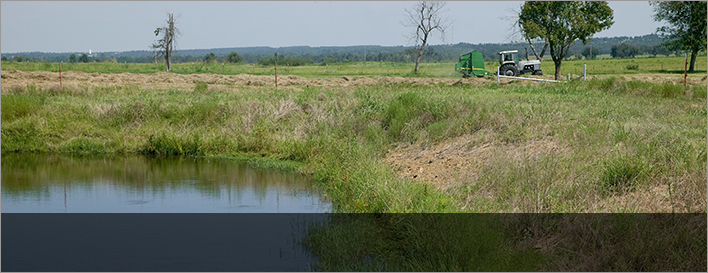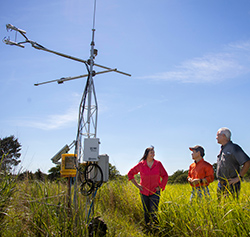Dr. Gail Wilson


Dr. Gail Wilson, professor of natural resource ecology and management at Oklahoma State University, is a member of the OK NSF EPSCoR Track-1 RII Award titled Socially Sustainable Solutions for Water, Carbon, and Infrastructure Resilience in Oklahoma. Wilson holds the Sarkeys Distinguished Professor in Rangeland Soil Ecology at OSU.
The $20 million EPSCoR research project is a social science-led, multi-disciplinary collaboration among social, physical, biological, engineering, and computational scientists. More than thirty researchers from across the state are working together on the project, which began July 1, 2020.

Dr. Wilson's research interests are in plant community ecology, plant-soil microbe interactions, and plant-animal interactions, utilizing a combination of experimental field and greenhouse studies. The majority of her research focuses on rangeland ecology and management, fire ecology, nutrient dynamics, and grassland restoration, with an emphasis on belowground mechanisms such as mycorrhizal symbiosis and belowground populations of meristems. Dynamics within the soil community can be a major driver of the plant community. For example, Dr. Wilson's research indicates that mycorrhizal fungi contribute to community processes and functions through their establishment of linkages and feedbacks between plants and nutrient cycles. Other research she is currently involved with includes invasive species and woody plant expansion in grasslands, restoration of rangelands, and the importance of resource availability (specifically soil P, N, and light) as controllers of the mutualistic function of arbuscular mycorrhizal symbiosis.
Dr. Wilson's research supports Focus Area 2: Terrestrial Water & Carbon Dynamics (TWCD) of the OK NSF EPSCoR project. Through her research, Dr. Wilson advances the team's goal of, "collecting and calibrating data to inform management decisions that will alter ecosystem productivity and carbon storage as well as water yield for agricultural, municipal, industrial, and ecological purposes." The TWCD focus area is central to the wicked problems facing Oklahoma because of conflicting policy narratives that shape concerns about carbon management and risks associated with landscape management practices (e.g., wildfire risks). At the same time, linkages across the TWCD and other focus areas provide opportunities to engage key stakeholder groups in discussions addressing both problem definition and potentially sustainable solution sets. Land use/carbon cycle issues play this crucial role because of the interactions among terrestrial ecosystems and carbon and water cycling, which are in turn integral components of the other impact domains addressed in this research project.
Pictured (above): Dr. Gail Wilson, along with co-researchers Drs. Chris Zou and Rodney Will, at a monitoring site in Oklahoma.
- Zhou, J., G.W.T. Wilson, A.B. Cobb, G. Yang, and Y. Zhang. 2019. Alfalfa Seeding, Phosphorus Amendments, and Mowing Facilitate Restoration of Diverse and Highly Productive Grasslands. Landscape Degradation and Development. 30:647-657.
- Hoeksema, J.D., J.D. Bever, S. Chakraborty, V.B. Chaudhary, M. Gardes, C.A. Gehring, M. M. Hart, E. A. Housworth, W. Kaonongbua, J.N. Klironomos, M.J. Lajeunesse, J. Meadow, B.G. Milligan, B. Piculell, A. Pringle, M.A. Rúa, J. Umbanhowar, W. Viechtbauer, Y-W. Wang, G.W.T. Wilson, P.C. Zee. 2018. Evolutionary History, not Environmental Context, Best Predicts Strength of Mycorrhizal Mutualism. Nature: Communications Biology. 1:116. DOI: 10.1038/s42003-018-0120-9
- Gui, W., H. Ren, Y. Zhang, A.B. Cobb, G.W.T. Wilson, X. Sun, J. Hu, Y. Xiao, F. Zhang, and G. Yang. 2018. Plant Functional Group Influences Arbuscular Mycorrhizal Fungi and Soil CO2 Efflux in Temperate Grasslands. Plant and Soil. 432:157-170.
- Cobb, A.B., G.W.T. Wilson, C.L. Goad, S.R. Bean, T.T. Tesso, and J.D. Wilson. 2017. Assessing the Influence of Fertility Inputs, Field Management, and Sorghum Genotypes with Soil Microbial Communities and Grain Quality. Applied Soil Ecology. 119:367-374.
- Cobb, A.B., G.W.T. Wilson, C.L. Goad, S.R. Bean, R.C. Kaufman, T.J. Herald, and J.D. Wilson. 2016. The Role of Arbuscular Mycorrhizal Fungi in Grain Production and Nutrition of Sorghum Genotypes: Enhancing Sustainability through Plant-microbial Partnership. Agriculture, Ecosystems, and Environment. 233:432-440.
- Duell, E.B., G.W.T. Wilson, and K.R. Hickman. 2016. Above- and Belowground Responses of Native and Invasive Prairie Grasses to Future Climate Scenarios. Botany. Special Edition: Mycorrhiza and Climate Change. 94:471-479.
- Greer, M.J., G.W.T. Wilson, K.R. Hickman, and S. Wilson. 2014. Experimental Evidence that Invasive Grasses use Allelopathic Biochemicals as a Potential Mechanism for Invasion: Chemical Warfare in Nature. Plant and Soil. 385:165-179.
- Johnson, N.C., G.W.T. Wilson, M.A. Bowker, J.A. Wilson, and R.M. Miller. 2010. Resource Limitation as a Driver of Local Adaptation in Mycorrhizal Symbioses. Proceedings of the National Academy of Sciences. 107:2093-2098.
- Wilson, G.W.T., C.W. Rice, M.C. Rillig, A. Springer, and D.C. Hartnett. 2009. Soil Aggregation and Carbon Sequestration are Tightly Correlated with the Abundance of Arbuscular Mycorrhizal Fungi: Results from Long-term Field Experiments. Ecology Letters. 12:452-461.
- Wilson, G.W.T. and D.C. Hartnett. 1998. Interspecific Variation in Plant Responses to Mycorrhizal Colonization in Prairie Grasses and Forbs. American Journal of Botany. 85:1732-1738.
